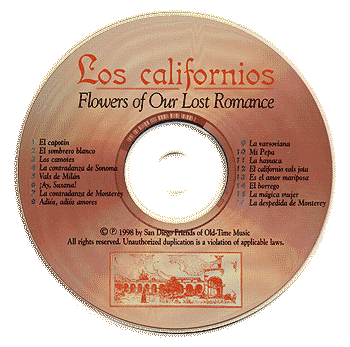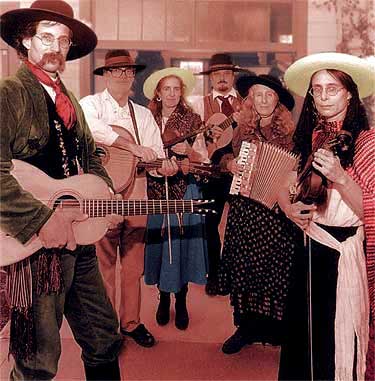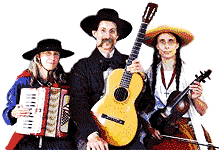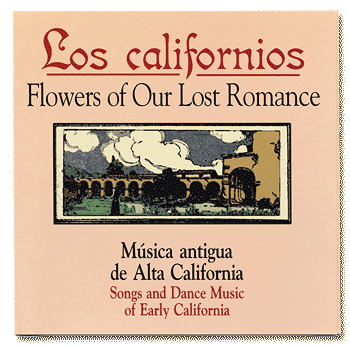Flowers of Our Lost Romance — Contents

|
- El capotín (5:25)
- El sombrero blanco (4:22)
- Los camotes (4:19)
- La contradanza de Sonoma (2:03)
- Vals de Milán (6:01)
- ¡Ay, Susana! (2:05)
- La contradanza de Monterey (2:28)
- Adiós, adiós amores (3:44)
- La varsoviana (3:08)
- Mi Pepa (4:49)
- La hamaca (5:05)
- El californio vals jota (2:55)
- Es el amor mariposa (5:16)
- El borrego (1:44)
- La mágica mujer (2:38)
- La despedida de Monterey (3:40)
|
Flowers of Our Lost Romance — Notes

Album Notes by Vykki Mende Gray
Once upon a time, in a land not so
far away and a time not so long ago, a scattered
population of racially mixed pioneer settlers sought
paradise. The land was called alta California, the
time was the heyday of the California missions and
ranchos from the 1770s through the 1840s, and the
people called themselves californios. The rancho
homes were far apart, so a visit was an event. Friends
and relatives from far and wide might gather together
at a rancho for singing, dancing, dining and visiting.
Although related to both, this California
music is not Mexican and it is not Spanish. Some
pieces did come to California with settlers coming
from Mexico before 1848, bringing with them their
already diverse heritage from Spanish, indigenous
Mexican and African roots. Some pieces came from
other southwestern Hispanic and Native American settlements,
such as those in New Mexico, through trade and marriage.
Other pieces were written here, some came from the
traditions of the local Native American musicians,
and some came with trade from passing ships.
With the coming of the American period
and the sudden immigration of great quantities of
people from other places, the culture and heritage
of the californios began fading away into the new
dominant culture.
In 1903 Charles
Fletcher Lummis, a transplanted Californian
who became a champion of the Southwest and its
Native American and Hispanic cultures, took on
an immense project. With his charter in hand for
the Southwest Society, a chapter of the Archaeological
Institute of America, he purchased an Edison wax
cylinder recording machine and proceeded to “catch
our archaeology alive” by recording the disappearing
songs of the californios and Native Americans.
He recorded californio descendants singing hundreds
of songs, and those Edison wax cylinders still
extant now reside at the Southwest Museum in Highland
Park. In writing of his project, Lummis described
these pieces as the “flowers of our lost
romance,” hence the title of our album.
Some of the same informants from whom Lummis collected songs were also informants for dances
from Mexican California, allowing tunes and dances to survive in dance circles through the several romantic
revival periods in California.
The link with historic californio families was still strong when Charles Lummis began
recording songs in 1903. As examples:
Doña Adalaida Cordero Higuera Kamp
— an informant who recorded 65 pieces for Lummis — was descended from the Higuera
family and grew up learning songs in the household where
José de la Rosa,
known affectionately as Don Pepe, resided. Don Pepe,
sometimes credited with being California’s first professional
printer, came to California in 1833 with the Híjar-Padrés
party. He was also a popular musician, singer and composer
who protected his material jealously so his competitors would
not learn it. But he was impressed with the musical talent
of the young Adalaida, and at his death he willed her his wordbook
of songs carefully written out in his own hand. Doña
Adalaida in turn transcribed the words to her own songs, leaving
both her typewritten wordbooks and Don Pepe’s wordbook
in the archives of the Southwest Museum.
The californio family of
Rosa and Luisa Villa came to alta California
from Baja California in 1846. These informants also played dance tunes
on the mandolin and guitar.
Nena and Susie del Valle, who taught Lummis traditional californio dances as well as songs,
were from the californio family that owned Rancho
Camulos. The del Valle family recorded 22 pieces
for Lummis. Click here for sheet music
of all the Rancho Camulos pieces.
Other resources we have used in recreating
the sound of californio music include the recordings
of the The Mexican Players at the Padua Hills Theatre, Danzas de alta
California — recorded by Gabriel Eulogius Ruiz
y Los cuates, and the personal research and recordings
of Al Pill, who dedicated much of his life to keeping
californio and Mexican traditional dance alive.
This album, Flowers of Our Lost Romance, is but a small sample of the rich secular music
heritage of California from this time when California was part of Mexico.
Flowers of Our Lost Romance — Details about the pieces
- El capotín (5:25)
“... a catchy little tune, known to all Spaniards” is how Gilbert Chase
described this folk song in his book, The Music of Spain, 1941. Even today it is one of the most
widely recognized pieces of those collected from californio informants, known not only to
Spaniards but also to persons from throughout Latin America, who delight in singing along. In 1904
Charles Fletcher Lummis recorded Mercedes García and Mrs. Melsing singing El capotín,
and also documented it from Rosa and Luisa Villa. Unfortunately, only Arthur Farwell’s transcriptions
of those recordings seem to have survived. We first heard this at Old Spanish Days in Santa Barbara sung by
Elizabeth Erro Hvolboll. The title refers to a type of rain cloak commonly made from tulles or palm
fronds.
- El sombrero blanco (4:22)
The lyrics accompanying this dance were collected by Lummis from two different
californio informants in 1904: Doña Adalaida Kamp and Porfirio Rivera. Some of the verses reflect
the song type in which impossible feats are demanded of a would-be wooer, who meets the demands with
word play rather than exertion. The chorus reflects, in nursery rhyme style, the political rivalries
of previous generations — with hat ribbons of white or blue denoting which camp one claims.
In the 1940 movie The Mask of Zorro, Tyrone Powers wins the heart of his intended while dancing to
this tune. Our version is also influenced by renditions recorded by the Mexican Players of Padua Hills
Theatre and Los cuates, and we learned a wonderful version of the dance from Al Pill.
- Los camotes (4:19)
This californio dance from the late 1700’s is described lovingly in
Don Antonio Franco Coronel’s 1877 memoirs about californio life in the period from 1834 to
1850. The lyrics make good-natured though humorous commentary on Franciscan life. As in many californio
dances, the dancers would sing the words while they danced. Helen Hunt Jackson, the author of
Ramona, claimed that Don Antonio was the best waltzer in Los Angeles. Coronel’s memoirs, Cosas
de California, are in the Bancroft Library in Berkeley. A 1904 recording of Porfirio Rivera singing this
piece is included in the Lummis collection of Edison wax cylinders.
Also, check out the programs for
La Fiesta Anual de Mayo at the Southwest Museum’s Casa de Adobe. The 1938 program says of
this piece, “This dance was first taught as a religious rite and later evolved into the dance now
portrayed,” while the 1940 program claims the piece was “taught the Mission Indians by the
padres.” These annual fiestas were organized by californio descendent Isabel C. Lopez de
Fages.
- La contradanza de Sonoma (2:03)
The contra dance was done in waltz time in Mexican California using figures
familiar to contra dances and running sets from other areas, and adding California’s own variations
with complicated knots and figures referencing and illustrating religious concepts. We again have the
the Mexican Players of Padua Hills Theatre to thank for preserving this piece.
- Vals de Milán (6:01)
Milán refers not to a town in Italy, but rather to the dashing young
man who goes flying in a hot air balloon — and invites enchanted young ladies to join him. One
part of the song still has currency both in Spain and Argentina:
Yo te daré cuando tú sepas querer —
te daré, te daré, vida mía,
una cosa que yo solo sé.
I will give you, when you know how to love —
I will give you, my beloved,
something that I alone know.
At which point the crowd yells: “¡Café!” (Coffee!)
Francisco Amate recorded this
for Lummis in 1904.
- ¡Ay, Susana! (2:05)
There are still californio descendants who remember hearing these old songs
from their grandparents. At the San Pasqual Battlefield one year we were fortunate to meet one of those
descendants, who brought us this californio version of Stephen Foster’s gold rush
favorite.
- La contradanza de Monterey (2:28)
Another californio contra dance, this dance could be done either with two lines of
dancers facing each other, or with the lines arranged as the inside and outside rings of a circle. The
Padua Hills Orchestra is our source for this piece.
- Adiós, adiós amores (3:44)
Lummis recorded this beautiful song in 1904 from the duet singing of Rosa
and Luisa Villa, and also from
Manuela García singing to the guitar accompaniment of
Rosendo Uruchurtu. It recounts the eternal story
of the jilted lover who will get even — by leaving. “See how you like that! You won’t have
me to kick around any more. No more love for me.” This song was one of Lummis’ favorites, and it
was sung for his funeral in 1928.
- La varsoviana (3:08)
The woman from Warsaw. Although one could be excommunicated for dancing
the waltz (and this version of this piece includes a waltz section in the third part), this was
nevertheless a popular dance — not only in rancho-era California but
worldwide. Lummis collected the words from Nena del Valle Cram in 1904, and from time to time we still
run into people who sang these words in their youth, both in California and in Mexico. Our tune is
greatly inspired by the rendition of the Padua Hills Orchestra.
- Mi Pepa (4:49)
A piece that retains a strong Spanish flavor even in its New World surroundings,
Lummis collected Mi Pepa in 1904 from both Manuela García and Nena del Valle Cram. The flirty
young Pepa seems to have been a young man’s dream — high born, but walks with a
wriggle!
- La hamaca (5:05)
“I have my hammock hung by the edge of the sea, and my hut hidden in the
banana field.” Rosa and Luisa Villa recorded this for Lummis in 1904.
- El californio vals jota (2:55)
Another wonderful dance tune preserved through recordings of The Mexican Players
at Padua Hills Theatre, and also recorded as La jota vieja by Gabriel Eulogius Ruiz with
Los cuates. Don Antonio Coronel’s memoirs describe the jota as the favorite popular
dance, with dancers filling all the available space. The two facing lines that started the dance
resolved into a double circle as men and women proceeded in opposite directions around the
room.
- Es el amor mariposa (5:16)
“Love is a butterfly — it flits from one flower to the next.”
Lummis recorded Manuela García and Rosendo Uruchurtu singing this beautiful old tango in
1904.
- El borrego (1:44)
Also described by Antonio Coronel, this dance utilized the convention of a
handkerchief to avoid actual physical contact by the dancers, and further played on the convention by
using the handkerchief to mimic a bullfighter. Our friend, Al Pill, taught us this dance. It is one of the
many californio and Mexican dances that are still remembered through his efforts. The song and its
accompanying dance are closely related to an old Mexican song-dance called
Los enanos.
- La mágica mujer (2:38)
Manuela García sang for Lummis, in 1904, this song of a magical
woman who bewitched merely with her look.
- La despedida de Monterey (3:40)
Another piece from Lummis’ wax cylinders, this song illustrates the isolation
of a community reached most easily by long and uncertain sea trips. The lyrics speak of a lover about to
be separated from the object of his affections by one of those trips. Doña Adalaida Higuera
Cordero Kamp, who also called it Último adiós a mi amante, recorded it in 1904. The
words are included in José de la Rosa’s wordbook. The tune is the same as that of an old
Russian song, on a similar topic, called Razluka.
El capotín
- Yo soy firme para amarte
y constante en el querer.
¡Qué trabajos pasa a un hombre
cuando quiere a una mujer! (bis)
Estribillo:
Con el capotín, tín, tín, tín,
que esta noche va a llover.
Con el capotín, tín, tín, tín,
¿qué será al amanecer? (bis)
- ¡Qué trabajos pasa a un hombre
cuando empieza a enamorar!
Toma vino. Se emborracha.
Y se acuesta sin cenar. (bis)
(estribillo)
- No me mates. No me mates
con pistola ni puñal.
Mátame con tus ojitos,
o esos labios de coral.
(estribillo)
El sombrero blanco
- Si quieras que yo te quiera
mande enladrillar el mar,
y después de enladrillado,
soy tuya y puedes mandar.
Es posible, padre mío,
que me sí es a padecer,
y que vaya a pasar trabajos
por faltando de la mujer.
Estribillo:
¿Quieres que te ponga
mi sombrero blanco?
¿Quieres que te ponga
mi sombrero azul?
¿Quieres que te siente
mi vida en un trono
para que te cante
el tu-run tun-tun,
el tu-run tun-tun?
- La cal está en la lancha,
la arenita en el mar.
Y los peces son los ladrillos —
ya está enladrillado el mar.
Las aguas cojo por el agua.
Las arenas por la sal.
Y los peces son los ladrillos —
ya está enladrillado el mar.
(estribillo)
- Si quieras que yo te quiera,
ha de ser de condición —
que lo tuyo ha de ser mío
y lo mío tuyo no.
Si quieras que yo te quiera
mande enladrillar el mar,
y después de enladrillado,
soy tuya y puedes mandar.
(estribillo)
Los camotes
- Los frailes de San Francisco
sembraron un camotal. (bis)
Y tanto que levantaron,
llenaron la catedral. (bis)
Estribillo:
Camotes, y más camotes,
calabacitas, chilicayota,
naranja dulce, limón partido —
dame un abrazo de amor, te pido.
Ámame, por Dios, que te ruego.
(estribillo)
- Los camotes se perdieron.
Los salieron a buscar. (bis)
veinticinco ganaderos,
los cabos y un oficial. (bis)
(estribillo)
Ámame, por Dios, que te ruego.
Ámame, por Dios, que te pido.
(estribillo)
- Las monjas de San Francisco
se comieron un camote. (bis)
Les hizo tanto daño
que les hizo andar en trote. (bis)
Tréboles, tréboles
con pimentorio,
azúcar y clavo y canelorio. (bis)
A Dios, a Dios,
a Dios adoremos. (bis)
(estribillo)
Vals de Milán
Vente conmigo a vivir
hechicera del corazón.
Yo te haré la mujer más feliz
que en el mundo he podido ver yo. (bis)
Yo te daré cuando tú sepas amar,
te daré, te daré, vida mía,
una cosa que te ha de gustar.
Yo te daré cuando tú sepas querer,
te daré, te daré, vida mía,
una cosa que yo sólo sé.
Cuando Milán de Valencia se marchó,
con grande afán de todos se despidió.
Y su mamá, llorando, le dice — ¡adiós!
¡Adiós, Milán de mi vida —
Milán de mi corazón.
¿Cuántas pollitas habrán
que a su mamá le dirán
— Mamá, yo me quiero ir
en el globo con Milán? (bis)
(alternate last part)
El día quince de mayo
cuando Milán se embarcó,
las pollitas de Valencia
todas le dicen — ¡Adiós! (bis)
|
¡Ay! Susana
- La Susana se paseaba
en un buque de vapor,
y lloraba por su amante,
y lloraba por su amor.
Estribillo:
¡Ay! Susana,
no llores por mí,
porque voy a California
a traer oro para ti.
- Poco tiempo San Francisco,
poco tiempo Mazatlán,
y volveré muy rico
con dinero pa’ gastar.
(estribillo)
- La Susana se paseaba
en un buque de vapor,
y lloraba por su amante,
y lloraba por su amor.
¡Adiós, adiós, amores!
- ¡Adiós, adiós, amores!
¡Adiós! porque me ausento
de tanto sentimiento
que tú me has dado a mí. (bis)
Por eso ya no quiero
amar más en la vida.
A mi patria querida
me voy a retirar.
- Tú prometes dulzuras,
y sólo das pesares.
Lágrimas a millares
se derraman por ti. (bis)
Y de tu cruel saeta
la herida está curada.
No más sacrificada
verás mi libertad.
- Desconsuelos y penas,
angustias y dolores
a tus adoradores
no más les sabes dar. (bis)
Por eso ya no quiero
amar más en la vida.
A mi patria querida
Me voy a retirar. (bis)
La varsoviana
— Varsoviana, varsoviana,
¿quién le trujo aquí?
— Yo solita, yo solita
vine a dar aquí.
El puro maíz, el puro maíz,
el puro maíz sin sal.
Al puro maíz, al puro maíz,
al puro maíz azul.
Mi Pepa
- Quiero a mi Pepa y no es broma,
porque es hembra muy formal.
Ella me hace delirar
si a la ventana se asoma.
Y toma. Y toma.
Dame en tu pico, paloma,
un granito de tu sal.
Vales más que el mundo entero.
¡Ay! salero, ven acá.
- Soy más duro que una peña,
y mi Pepa me deshace
con la mueca que me hace
y el ojito que me guiña.
Y toma. Y toma.
Dame en tu pico, paloma,
un granito de tu sal.
Vales más que el mundo entero.
¡Ay! salero, ven acá.
- No hay otra hembra en Sevilla
de más rango y más meneo,
ni de tanto zarandeo
como tiene mi Pepilla.
Y chilla. Y chilla.
Por Dios, niña, no me riñas.
Ni me hagas enfadar.
Vales más que el mundo entero.
¡Ay! salero, ven acá.
[alternate verse 2]
Soy más duro que una peña,
y mi Pepa me deshace
con un ojo que me arrima
y una mueca que me hace.
|
La hamaca
- Tengo mi hamaca tendida
en la orilla del mar,
y mi cabaña escondida
en medio de un platanal.
Sombra me da el bosque.
Brisa me da el mar.
Trinos el cenzontle —
¡qué bello es amar!
¡Qué bella es la vida!
Meciendo se va,
cual mi hamaca tendida
de aquí para allá,
de allá para acá.
- Recuerdos traigo en el alma
que me hacen mucho sufrir.
No me los mires con calma
porque me siento el morir.
Dame tú el alivio
a mi cruel penar.
Calma mi martirio.
No me hagas llorar.
Ven que entre mis brazos
te quiero arrullar
con el dulce murmullo
del agua del mar,
del agua del mar.
Es el amor mariposa
- Es el amor mariposa,
que a la salida del sol
extiende sus blancas alas
y vuela de flor en flor.
Es el amor un jilguero
que busca su nuevo placer
y manda sus dulces cantos
a la primera que ve.
Por eso, morena mía,
cuando te vi
te dije que te quería
con frenesí.
Y si mi negra me dice
lo que yo sé,
verás, verás que felices
vamos a ser, vamos a ser.
- Es el amor como niño —
caprichoso y juguetón
que por un juguete nuevo
desprécialo que le sirvió.
En este mundo, paloma,
todo pasa tan veloz
que nos deja saboreando
aquella que nos gustó.
Por eso, si no te enoja
este cantar,
esa, tu boquita roja —
ábrela ya.
Y si mi negra me dice
lo que yo sé,
verás, verás que felices
vamos a ser, vamos a ser.
El borrego
Señora, su borreguito
me quiere llevar al río.
Y yo le digo que no,
porque me muero de frío.
Sale la linda. Sale la fea,
y el borreguito con su zalea.
Sale el negrito con su garrote,
y el borreguito con su zalea.
Tope que tope — tope con ella.
Tope que tope — tope con él.
La mágica mujer
Una linda mágica mujer
me encantó con solo su mirar.
¿Es visión o no sé qué?
¿O es tan solo
un angel sin igual? (bis)
Con un beso ardiente que me dio
con sus labios de coral
me mató — me mató. ¡Ay!
Todito su amor a mi me lo entregó.
En mis brazos yo tenía
reclinada a mi María.
Vente, niña.Vente.
Yo quiero darte besos mil y mil.
Que el que te adora siempre será
tuyo y para ti.
La despedida de Monterey
- Ya la barca está en el puerto
esperando mi salida,
y un — ¡adiós! — a mi querida
tan sólo me resta dar.
No me olvides, linda Rosa,
aunque yo de ti me ausento.
Ten piedad de mi tormento.
No me vayas a olvidar.
¡Adiós! ¡Adiós!
¡adiós, mi querida, adiós!
¡Adiós! ¡Adiós!
¡adiós, mi querida, adiós!
- Nunca creas que yo te olvide
siempre que seas consecuente,
y aseguro que mi mente
sólo en ti se ocupará.
Recibe la despedida
de un amante que te adora,
y una lágrima que llora
te dará el último ¡adiós!
¡Adiós! ¡Adiós!
¡adiós, mi querida, adiós!
¡Adiós! ¡Adiós!
¡adiós, mi querida, adiós!
|
|




